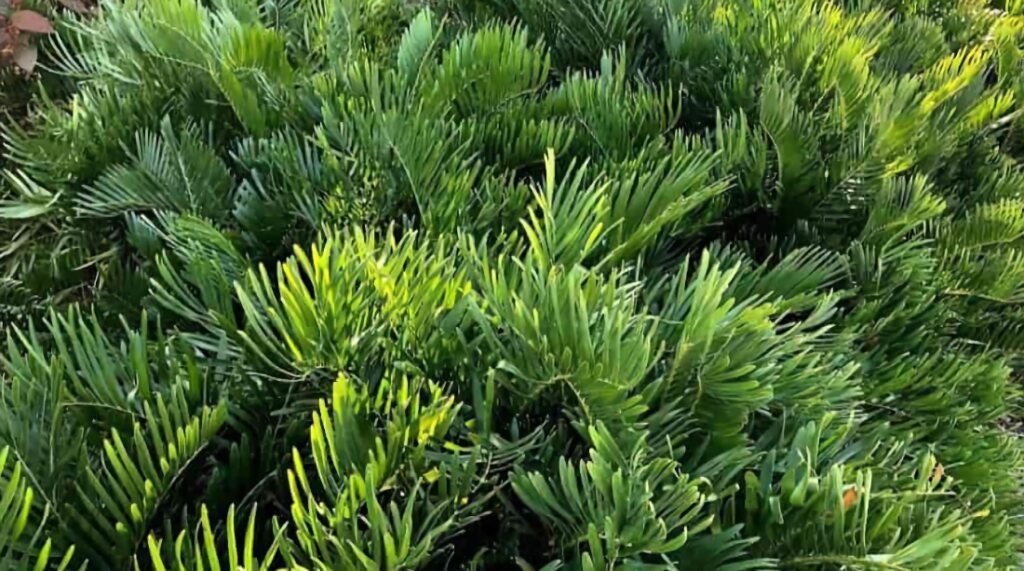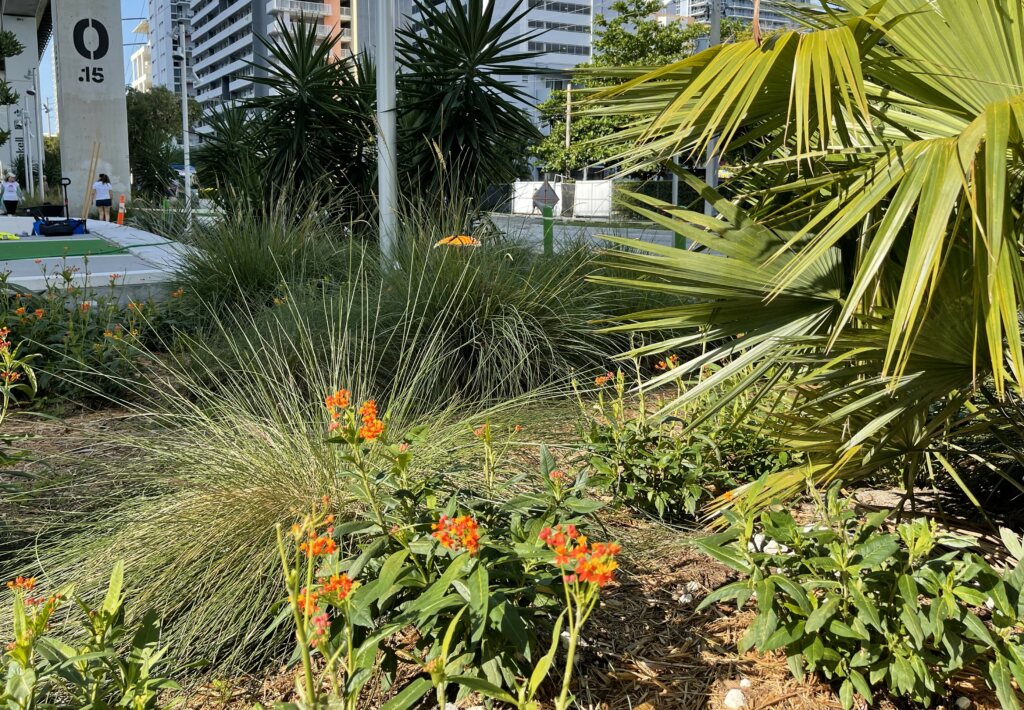Typoe Sculpture Garden
between SW 11th St and SW 10th St
Here in the Sculpture Garden you can see some of the planet’s oldest known plants. Ferns and cycads have been around since the dinosaurs and were some of the first plants to begin producing oxygen on Earth!! While you’re here, remember to breathe in the oxygen, and give thanks to these ancient plants!

Atala Butterfly
Hey there! Another native pollinator here! In case we haven’t met yet, I’m the Atala butterfly (Eumaeus atala). It’s nice to meet you. I may be smaller than other butterflies, but I have vibrant colors and a very interesting story! My wings are shiny and black with bright blue spots. I also have an orange blotch in the lower middle portion of my wings and abdomen. My flashy wings can scare other animals who might want to eat me. We are native to South Florida and can also be found in the Caribbean islands.
If you thought the Monarch caterpillars were picky eaters, wait until you hear about me. My caterpillars can only eat one species of plant, and that’s it. That plant is the unusual Coontie cycad (Zamia integrifolia), and it has been around since the age of the dinosaurs! As butterflies, we need to find coontie plants to lay our eggs on so that our caterpillars will have food when they hatch. Most animals cannot eat the leaves of coontie plants because they have a poisonous ingredient called cycasin. But that does not bother me at all. I think the leaves are delicous! When I grow into a butterfly, my favorite food is the nectar from lantana (Lantana involucrata) plants.
Did you know that the Atala butterfly was almost extinct? It’s true our important food source almost disappeared here in Florida and we began to starve. But amazingly, biologists found a small group of us and nursed us back to health. Through education and conservation, people like you started planting coontie plants in parks and in front of their homes for us to eat and now we are back and doing great! Want to help make more homes for us? You can plant Coontie at your home, or even keep them in a pot!
Keep reading to learn about the fascinating history of the Atala’s vital food source, the Coontie plant.
Fun Fact: Caterpillar defenses

Are you noticing a pattern? That’s right! Caterpillars like to eat poisonous plants! But how do we do it? The coontie, senna, milkweed, and even passion vine all have chemicals in their leaves which make them poisonous for other animals to eat. Amazingly, caterpillars can eat these plants without being harmed at all. Instead, caterpillars have an amazing secret superpower! When we eat poisonous plants, it makes us taste kind of yucky to other animals, so they won’t eat us. It is like my own shield of protection. Caterpillars take the toxins into their bodies and use them as protection against animals that might try to eat them. The same chemicals that make the plants poisonous, also makes the caterpillars poisonous to eat!
Snap a pic! Post your pics and be sure to tag us! #climatechamps @theunderlinemia
Coontie History
The coontie is an important plant native to the southeastern United States. It has a fascinating history with a strong connection between the land and the people living there. Native American tribes such as Calusa and Timucuan, and later the Seminole and Miccosukee, used this plants food for thousands of years, but commercial exploitation by European colonizers almost made it extinct. This means that there were only a few left in the world. This, of course, directly affected not just humans, but the Atala butterfly whose host plant is the coontie. If there is no host plant, there is no butterfly.
Florida’s indigenous people used the coontie’s roots to make flour to produce food such as bread, porridge and cakes. Interestingly, in the Seminole language, the word coontie roughly translates to “flour root”. They also dried the roots of the coontie to make remedies for stomach aches and skin irritation. This plant was an important part of their diet and culture.
The problem began when European settlers arrived in South Florida and learned the incredible value of this plant. They started harvesting it extensively and began to build large processing mills to produce coontie flour in large quantities. By the late 19th and early 20th centuries, the coontie had been overharvested and few could be found in the habitats where they were once abundant. To make things worse, as more settlers arrived, wetlands and pine rocklands where coonties grew, were drained, cleared, or built on, reducing their natural habitat even further.
Luckily, scientists, conservation programs, botanical gardens and nature lovers have been working together to rebuild the coontie population. They collect seeds and grow plants to save them. And that is something you can do too. You can find coontie plants grown at local nurseries and plant them in your yard!.Isn’t it amazing how this ancient plant almost disappeared, but thanks to the hard work of many people, it was saved and is now thriving? It shows us that by working together, we can make a big difference in the world and keep our planet beautiful and alive with fascinating life.
Carbon Sequestration
We hear a lot about carbon dioxide, but what about carbon?
Carbon is the ultimate multitasker in the world of chemistry. It is in almost every molecule that makes up living things and helps everything grow. Just like we need bricks to build a house, we need carbon to build the bodies of all plants, animals, and people. Carbon also exists in the air in the form of carbon dioxide.
Carbon dioxide, or CO2, is the greenhouse gas that contributes most to climate change. In the Earth’s natural balance, greenhouse gasses act like a blanket that keeps the planet nice and warm by trapping the sun’s heat and supporting life on Earth. However, human activities such as burning fossil fuels (like coal, oil and gas) have disrupted this balance by releasing too much CO2 into the atmosphere.
Climate change is an important topic today, and it refers to many topics you may have heard about, like rising sea levels, higher temperatures, and more severe and unpredictable weather patterns.
One way to restore Earth’s natural balance of greenhouse gasses and help reverse climate change is by “carbon sequestration”. To “sequester” means to put something into storage for a long time. Carbon sequestration is the process of capturing and storing carbon from the atmosphere. The Earth sequesters carbon naturally within the plants, the ocean, and the soil.
Plants play a critical role in carbon sequestration. All plants absorb CO2 from the air through a process called “photosynthesis” –Using energy from the sun and water from the rain, plants can separate CO2 into carbon and oxygen. They use carbon to build their leaves, stems, and roots while releasing oxygen for us to breathe. Trees can store carbon for a very long time, sometimes hundreds or even thousands of years.
The Underline is doing its part to reduce CO2 by transforming the space under the Metrorail with lots of plants and trees.
These plants and trees help absorb CO2 and other pollution that comes from cars.
But planting trees helps to reduce greenhouse gasses in more ways than one! Carbon gets stored in the wood of trees for years and years. Decomposing leaves help to create healthy soil, and tree roots help filter pollutants from stormwater and keep our oceans clean from chemicals.
